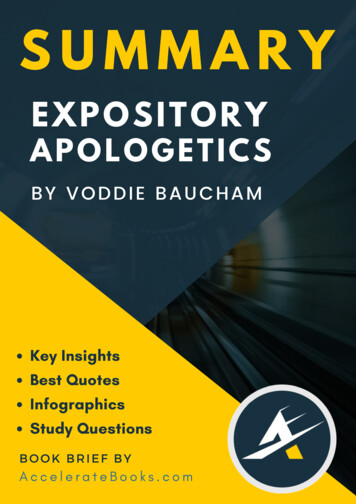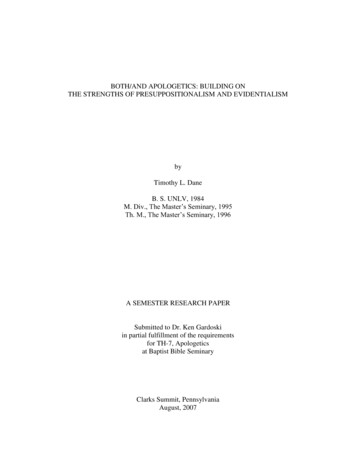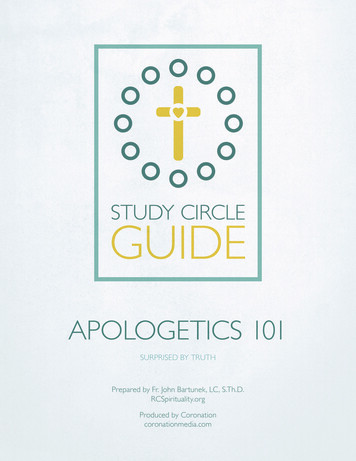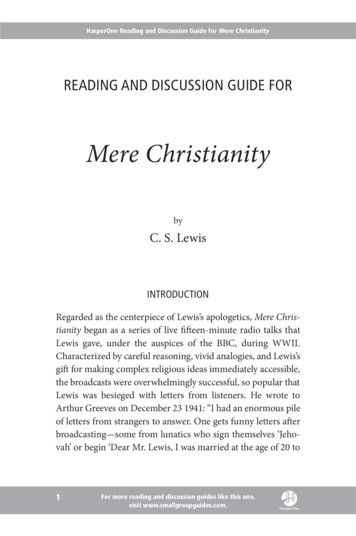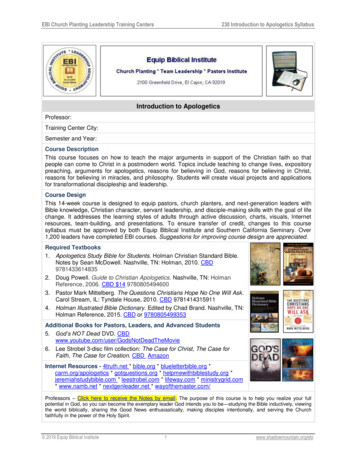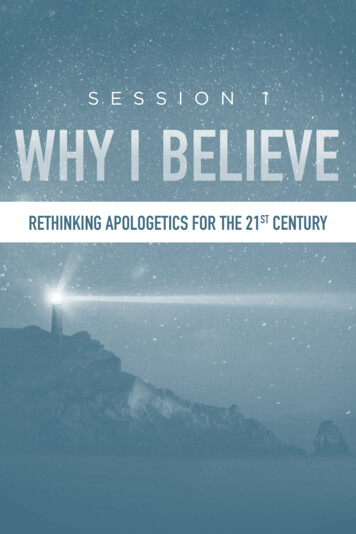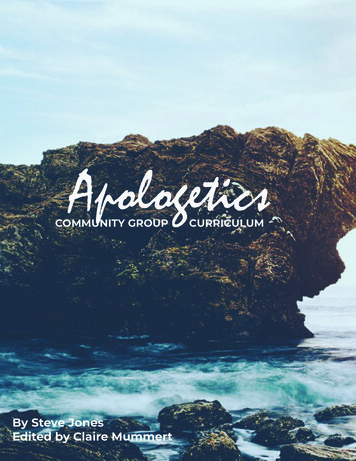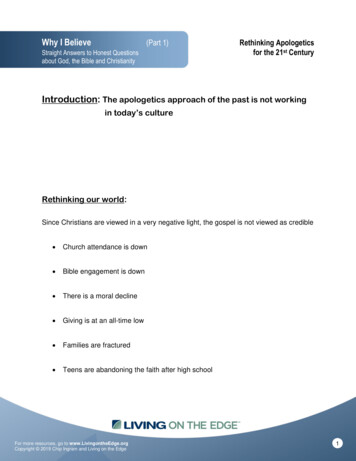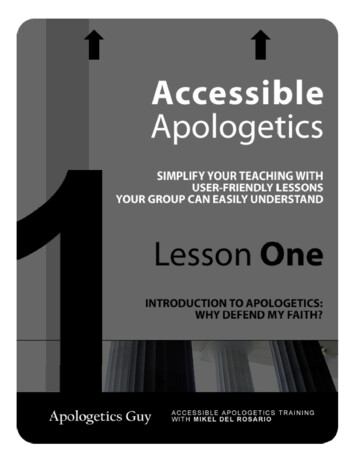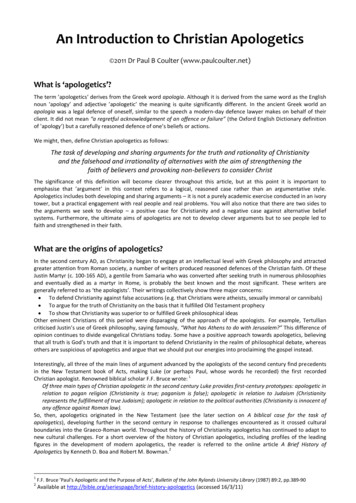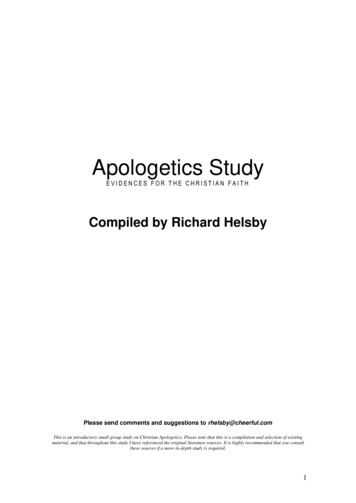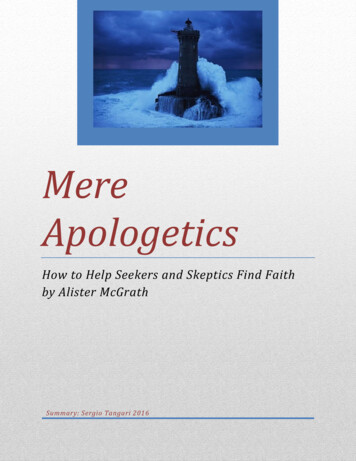
Transcription
MereApologeticsHow to Help Seekers and Skeptics Find Faithby Alister McGrathSummary: Sergio Tangari 2016
Mere Apologetics: How to Help Seekers & Skeptics Find Faith 2012 Alister E. McGrath, Baker Publishing House: Grand Rapids, MichiganCHAPTER 1: GETTING STARTED (Pgs. 11-25)Our mandate has been given by Christ in the Great Commission both withcontent for teaching and power for execution. Christ’s word is what we teach andGod’s presence is what Jesus promised. That’s why when we are about doing theMasters business never are we to think we’re alone.We are to understand apologetics as the reasoned defense of the Faithwhich must be practiced with gentleness and respect toward outsiders—thosewho are our persecutors (Pg.16 see section). Apologetics defends, commends,and translates the Faith to seekers and believers. When defending we mustanswer honest questions and be person relative. When commending we mustshow the wonder and splendor of the kingdom. And when translating, we mustdo so exegetically, hermeneutically and humanly explain terms so that a child canunderstand our meaning.Christians wanting to grow in their faith need to and must find answers totheir questions. They must mine the riches of the faith and get proficient atexplaining it creatively without losing the substance of the gospel.The distinction between Apologetics and Evangelism is important and notso easy. The former explains the Faith and removes barriers to hearing itsproclamation and invitation as the latter does. Sometimes these two areneglected—apologetics (pg.22) and evangelism (pg.22)Apologetics and evangelism are necessary conditions for real conversionsto obtain, but not a sufficient condition until the Holy Spirits’ activity manifests inthe souls of dead people to bring them to life.CHAPTER 2: APOLOGETICS AND CONTEMPORARY CULTURE (Pgs. 27-40)Our apologetics must be in touch with the culture and audience before us.While we can and do learn from the past, it’s important to speak in contemporaryterms in order to humanly connect with others.McGrath writes about modernity and post-modernity. Modernity (M)viewed human reason as universal, available to all, able to unlock the mysteries oflife, and argument was reasons tool for the task. During this era, Christianapologetics mainly focused on reason and rational arguments to commend the1Sergio R. TangariSummary of ChaptersMere Apologetics: How to Help Seekers & Skeptics Find Faith, 2012 Alister E. McGrath, BakerPublishing House: Grand Rapids, Michigan
faith, but neglected the relational and creative side of being human (pg. 28). Thismoreover minimized the mystery of the Faith (E.g., the Trinity was not used as anapologetic) and in order to win arguments some gave over too much real estateand assumed the opponents worldview and ended up losing the heart of thematter.Post-Modernity (PM) is not easy to define but is easier to describe. It saw(M) as a failure needing correction. Of course not all of (M’s) ideas are bad. Thus(PM) attempted to combine the best of (M’s) and that of Classical Tradition (CT)while removing their undesirable aspects. Among these undesirable aspects wasuniformitarianism—a kind of reductionism that has a “total-scheme” of reality likeMarxism. PM’s see this as a “straight-jacket” that essentially infringes on humanfreedom. Now PM’s reject several things.First, they reject the notion that there’s only one right or wrong way to live.Second, they see “sameness” as belittling to human freedom, thus diversity is tobe celebrated. Therefore any metanarrative is to be rejected as a way of lookingat the world. Third, they see reason not as universal but rather contextual andrelative. Fourth, they have a suspicious view of truth and hold that it’s used bythe powerful to justify their oppression and to maintain their positions of powerand authority. Fifth, they reject the idea that history has some kind of telos (E.g.,Jesus of Nazareth). Sixth, they refuse the view that the “self” has some point ofreference, but instead the “self” is a fluid way of seeing ourselves.PM’s contributes at least two appreciative qualities. First, it’s a secularworldview that does not define what’s “right/wrong” and is neither pro/conChristianity. Second, this movement in culture presents an opportunity for a newapologetic approach focused not merely on reason and arguments but also onstory, imagination (I.e., the parables of Christ) and an incarnational approach.How are we to reach our culture and do apologetics in this milieu? Wemust first start by knowing the Gospel, secondly understanding our times andthus tailor-make our approach accordingly, third, so that the content of themessage remains faithful to the /Master, while the methods adapt to theaudience for human connection.CHAPTER 3: THE THEOLOGICAL BASIS FOR APOLOGETICS (Pgs. 41-55)In this chapter McGrath argues that apologetics is not primarily aboutargumentation and winning arguments but rather about being mastered by the2Sergio R. TangariSummary of ChaptersMere Apologetics: How to Help Seekers & Skeptics Find Faith, 2012 Alister E. McGrath, BakerPublishing House: Grand Rapids, Michigan
Christian faith in such a way that its ideas, themes, and values are deeplyembedded in our souls.Simon, Andrew, Philip, and Nathanael were impacted not by arguments butby an encounter with Christ. This means that we need to get people to beholdwho Jesus is in the gospel accounts. That’s a powerful apologetic. When wepoint people to Jesus they have an opportunity to behold his glory and thus betransformed from death to life.Again, McGrath accentuates the fact that if Gods does not move upon deadhearts, there will be no change. Their blindness must therefore be removed inorder for them to see. We have the small role of removing obstacles to the faiththrough apologetic engagement, but only God can heal the malady of sin.McGrath uses the analogy of penicillin to show that God is the healer(pg.46), he then uses the analogy of landscapes to show how we need to helppeople discover the glories of the faith (pg.47), and he uses the analogy of a prismto show the many facets of the Christian gospel help one appreciate the otherfacets (pgs.47-48).McGrath reminds us that we are to show that the cross grounds humanforgiveness, how it coupled with the resurrection grounds death’s end, how thecross also brings healing to our broken lives and finally that the cross displaysGod’s love. We accomplish this by establishing the historicity and thereby thesignificance of the aforesaid. But we must do this gently with those who strugglewith any of the areas mentioned.This means that there’s forgiveness for sinners, healing for the broken,relief for those fearing death, and for the unloved God’s boundless merciesdemonstrated.CHAPTER 4: THE IMPORTANCE OF THE AUDIENCE (Pgs. 57-70)In this chapter McGrath argues that the book of Acts and the Gospelaccounts should be used as an apologetic for non-believers and skeptics seekingfaith. The reason is because unlike Paul’s letters which are primarily addressed tothe believing community (his audience) not skeptical seekers, Acts and theGospels are.In the book of Acts, McGrath points out three different apologeticapproaches that are audience sensitive thus making the gospel presentation moreimpacting. First, before his Jewish audience, Peter’s apologetic appeals to the Old3Sergio R. TangariSummary of ChaptersMere Apologetics: How to Help Seekers & Skeptics Find Faith, 2012 Alister E. McGrath, BakerPublishing House: Grand Rapids, Michigan
Testament for his proclamation. He explained the fact of Christ’s life, death andresurrection and interpreted its meaning, namely, that Jesus of Nazareth is thelong awaited Messiah. Peter appealed to the authority for monotheistic Jews—Torah, and grounded his message in it (Acts 2-4).Second, before his Athenian audience, Paul’s apologetic appeals tocommon ground on Mars Hill. Here, Paul explains the nature of who the“unknown God” is, by appealing to creation, their poets and finally Christ’sresurrection. Had Paul appealed first to the Scriptures, it would not have beeneffective (he probably wouldn’t have gotten an audience) because Torah was notauthoritative to the Athenians, but their philosophers were (Acts 17).Third, before the Roman Court, Paul’s apologetic appeals to legalterminology and reasoning. The apostle here by using the language of the courtculminates his message in Christ’s resurrection which assures God’s nearness andthus none can hide from Him (Acts 25-27).These examples serve as a reminder to all believers that the audience doesand should (generally speaking) consider the audience before a particularapologetic approach is followed.McGrath affirms that critics and skeptics abound, thus depending on theperson and the situation, our methods must change but never our message.That’s obvious in Acts and should be in our encounters as well. This will requireloving sacrifice of our time, energy and money to get better equipped. See pages68-70 for general and specific examples of dealing with differing worldviews.CHAPTER 5: THE REASONABLENESS OF THE CHRISTIAN FAITH (Pgs. 71-91)McGrath argues that through arguments and evidence Christianity’sreasonableness obtains and makes more sense out of reality as we know it thanits’ rivals, thus giving veracity to Christianity’s claims.When addressing the issue of faith McGrath for me was not as clear. Heseemed to argue that the Christian faith is cognitively true (i.e., believing “x” istrue), relational and existential (i.e., trust in a person—Christ, not just an idea).He points out that the New Atheists, as everyone else, comes at reality withpresuppositions that are not argued but asserted. I believe McGrath’s point isthat like Christians, these atheists believe things they also can’t prove to be true.McGrath then focuses on how we all know things and differentiatesbetween mathematical certainty and abductive probability, and explains that4Sergio R. TangariSummary of ChaptersMere Apologetics: How to Help Seekers & Skeptics Find Faith, 2012 Alister E. McGrath, BakerPublishing House: Grand Rapids, Michigan
every area of human knowledge falls into one or the other category. Hecontinues and holds that if Christianity’s reasonableness is not championed,people will view it as irrational and thus defenseless. In the spirit of C.S. LewisMcGrath points out that through the reasonableness of Christianity it illumines allof reality as we know it.He then explains how philosophy can help us apologetically by chowing ushow to arrive at: causal explanations, inferences to the best explanations andunificatory explanations. There’s more. Yet, for all the help this chapter gives, itseemed to me that McGrath lacked clarity on the use of terms like: faith, belief,etc., which left me a bit frustrated. I guess that’s part of the writing,communicating and learning enterprise for us all.CHAPTER 6: POINTERS TO FAITH—Approaches to Apologetic Engagement (Pgs.93-124)We live in a world and society that's inundated with information butsimultaneously can’t synthesize it. That is, what the information pointsto and what’s its significance eludes us. McGrath reminds the readerthat: “Christianity gives us a way, of bringing order and intelligibility to our manyand complex observations of the natural world, human history, and personalexperience”. Moreover, it allows us to integrate what is discovered so that amosaic or tapestry of reality as we know it obtains.He argues for a cumulative case approach to apologeticengagement. Here, what we observe from the external and internal world ofhuman experience makes rational sense from a Christian worldview which helpsus synthesize and thus unfold life’s meaning.McGrath acknowledges that our epistemological finitude (limited view ofknowledge) is real when compared to deductive vs. abductive arguments, thelatter of which yields probabilities as opposed to mathematic certainties andthat’s why using a cumulative case approach to apologetics is a crediblestrategy. It’s likened unto the court room approach ofallowable evidence that's “beyond a reasonable doubt” to either indict or acquitthe defendant.The cumulative case approach according to McGrath are “pointers tofaith” such as; the origins of the universe along with Bib Bang cosmology andconcludes that the established data fits better in a theistic universe than a5Sergio R. TangariSummary of ChaptersMere Apologetics: How to Help Seekers & Skeptics Find Faith, 2012 Alister E. McGrath, BakerPublishing House: Grand Rapids, Michigan
naturalistic one. Again, he points out that the universes’ “fine tuningprinciple” which makes life possible as we know it seems to point out that there'sa a designer who had us in mind, rather than blind, random chanceevents. Moreover, he considers the structure of the physical world and itspredictable constants which make science possible and concludes that a theisticworldview makes better sense of the data than a chaotic one.McGrath offers other clues in his cumulative case pointers to faith whichinclude: human morality, a persons’ desire, the issue of beauty, the need forrelationships, and the concept of eternity as a means to “weave” a coherent“tapestry” of reality in order to get a conversation started. After each section hethen offers the possible apologetic value of each clue and how it may beapologetically used. I think this sampling of pointers to faith is a great place tostart and depending on the audience, one clue will be preferable overothers. This chapter felt much like a "workshop approach" to apologetics ratherthan a lecture format. I enjoyed it.CHAPTER 7: GATEWAYS FOR APOLOGETICS—Opening the Door to Faith (Pgs.127-156)McGrath points out that the goal of Gateways to Apologetics is to helppeople see what they could not previously or mistakenly thought they understoodabout Christianity. He chose several steps to accomplish this goal.First, explain the gospel using creation, fall, redemption and consummationas hooks. Second, use presuppositional reasoned arguments and show howjustified true belief in God makes sense of reality compared to Christianity’s rivalworldview. Third, use story, personal testimony and parables in order tocommunicate the gospel. Fourth, use images of the Exile or Paul’s meaning ofadoption in order to point out our human desire to belong and longing for home.Moreover, the use of the Arts helps the apologist relate popular stories asshadows of the gospel message.The lesson I’ve taken from this chapter is that McGrath is challengingapologists to be creative and culturally sensitive in order to secure an audiences’attention and interest to more effectively communicate the gospel message.6Sergio R. TangariSummary of ChaptersMere Apologetics: How to Help Seekers & Skeptics Find Faith, 2012 Alister E. McGrath, BakerPublishing House: Grand Rapids, Michigan
CHAPTER 8: QUESTIONS ABOUT FAITH—Developing Approaches (Pgs. 157-179)McGrath argues that the times in which we live must and will dictate thequestions we are asked and the requisite answers we give. A critical key is tonever answer a question that’s not being asked. This is a pit many have fallen intoand must be avoided if we desire to effectively connect with skeptics or seekers.Whether in an Islamic, rationalist, or postmodern context, the apologistmust welcome challenging questions and not see them as threats but as part ofthe journey the questioner is on. In other ways, these are doors to “faith” thatrequire a person relative response, rather than a “cookie-cutter” approach. It isone way we help people on their journey a step at a time.McGrath thus encourages each apologist to develop their own responses toquestions asked. Under the heading Concerns and Questions he offers thefollowing suggestions when interacting with skeptics or seekers: First, be graciouswith people even though they may not be. How powerful and foundational this is.People don’t care about what we know, as the saying goes, unless they know howmuch we care.Second, get to the real question being asked. Often the introductoryquestion has a motive or purpose for why it’s being asked. Get clear on that andyou’ll be more of a sniper with your responses instead of a greenhorn.Third, be humble to learn from others. You don’t know everything and it’salways easier to interact with one who’s not a “know-it-all”, than one who’s apeer on the learning journey. This does not mean that what you do know isdenied, but what you don’t know is admitted.Fourth, don’t give ready-made answers. It’s robotic, sterile, and does nothumanly connect. Instead, be a good listener where clarification of terms andideas are reiterated to the questioner.McGrath follows this section by providing a model of questions andanswers that can be offered to the skeptics’ challenges (E.g., God’s goodness andsuffering, God as a crutch, etc.) by pointing out the origins, presuppositions andproblems that obtain with the objection and offers a solution. With the “crutch”view he explains that the real issue here is truth and the nature of reality, ratherthan how it makes one look or feel.He finally ends the chapter by posing several questions and offering therequisite homework for the apologist to form and re-write her own responses.7Sergio R. TangariSummary of ChaptersMere Apologetics: How to Help Seekers & Skeptics Find Faith, 2012 Alister E. McGrath, BakerPublishing House: Grand Rapids, Michigan
The goal here is to tighten and shorten responses so that we get to the pointwithout losing the audience.CHAPTER 9: CONCLUSION—Developing Your Own Apologetic Approach (Pgs.181-185)McGrath ends his book by encouraging the reader to only use argumentsthat are personally satisfying because if they are not, they lose their effectivenesshumanly. He explains the importance of knowing yourself (both strengths andweaknesses) so that apologetically you have a starting point from which to spring(E.g., he was an atheistic scientist before conversion and integrates thisbackground in his apologetic).McGrath points out that apologetics is done either through public speaking,authoring books, personal conversations and a life lived to God’s glory. Hefurther accentuates the need to learn from other apologists by scrutinizing theirapproach to the subject, their interaction with dissenters, etc. and reverseengineer their arguments. Here, the “design” of apologetics is observed recallingthat it’s not just a discipline but also an art.After learning the aforesaid, the apologist must then make the argumentsand approach their own by incorporating who “they are” in the interaction.Lastly, he encourages apologists to practice in front of peers who can critique andencourage them on the journey. Perhaps gathering a group of like-mindedpeople who meet regularly in order to help sharpen and enhance apologetic skill.Above all, he explains how critical it is for apologists to be part of theChristian community where they receive and give support to the local churchbecause (other than it being biblical) the apologetic battles are taxing on the souland can be dangerous to it.8Sergio R. TangariSummary of ChaptersMere Apologetics: How to Help Seekers & Skeptics Find Faith, 2012 Alister E. McGrath, BakerPublishing House: Grand Rapids, Michigan
The distinction between Apologetics and Evangelism is important and not so easy. The former explains the Faith and removes barriers to hearing its proclamation and invitation as the latter does. Sometimes these two are neglected—apologetics (pg.22) and evangelism (pg.22) Apologetics and
